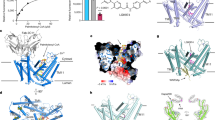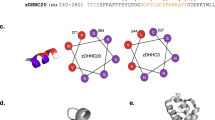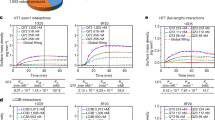Abstract
Protein palmitoyltransferases (PATs) represent an exciting new target for anticancer drug design due to their pivotal roles in the subcellular localization of a number of oncogenes. We show that the Huntingtin interacting protein 14 (HIP14) is a PAT with a preference for the farnesyl-dependent palmitoylation motif found in H- and N-RAS. Characterization of HIP14 in mouse cells has revealed that it has the ability to induce colony formation in cell culture, anchorage-independent growth, and tumors in mice. Activity of the enzyme and its ability to transform cells is dependent on critical residues in the active site of the enzyme.
This is a preview of subscription content, access via your institution
Access options
Subscribe to this journal
Receive 50 print issues and online access
$259.00 per year
only $5.18 per issue
Buy this article
- Purchase on Springer Link
- Instant access to full article PDF
Prices may be subject to local taxes which are calculated during checkout




Similar content being viewed by others
References
Alland L, Peseckis SM, Atherton RE, Berthiaume L and Resh MD . (1994). J. Biol. Chem., 269, 16701–16705.
Anderson RG . (1998). Annu. Rev. Biochem., 67, 199–225.
Apolloni A, Prior IA, Lindsay M, Parton RG and Hancock JF . (2000). Mol. Cell. Biol., 20, 2475–2487.
Bartels DJ, Mitchell DA, Dong X and Deschenes RJ . (1999). Mol. Cell. Biol., 19, 6775–6787.
Booden MA, Baker TL, Solski PA, Der CJ, Punke SG and Buss JE . (1999). J. Biol. Chem., 274, 1423–1431.
Bouvier M, Loisel TP and Hebert T . (1995). Biochem. Soc. Trans., 23, 577–581.
Camp LA and Hofmann SL . (1993). J. Biol. Chem., 268, 22566–22574.
Camp LA, Verkruyse LA, Afendis SJ, Slaughter CA and Hofmann SL . (1994). J. Biol. Chem., 269, 23212–23219.
Danesi R, Nardini D, Basolo F, Del Tacca M, Samid D and Myers CE . (1996). Mol. Pharmacol., 49, 972–979.
Das AK, Dasgupta B, Bhattacharya R and Basu J . (1997). J. Biol. Chem., 272, 11021–11025.
Degtyarev MY, Spiegel AM and Jones TL . (1994). J. Biol. Chem., 269, 30898–30903.
Downward J . (2003). Nat. Rev. Cancer, 3, 11–22.
Dunphy JT and Linder ME . (1998). Biochim. Biophys. Acta, 1436, 245–261.
Eummer JT, Gibbs BS, Zahn TJ, Sebolt-Leopold JS and Gibbs RA . (1999). Bioorg. Med. Chem., 7, 241–250.
Gorodinsky A and Harris DA . (1995). J. Cell. Biol., 129, 619–627.
Gutierrez L and Magee AI . (1991). Biochim. Biophys. Acta, 1078, 147–154.
Hancock JF, Magee AI, Childs JE and Marshall CJ . (1989). Cell, 57, 1167–1177.
Hiol A, Caron JM, Smith CD and Jones TLZ . (2003). Biochim. Biophys. Acta, 1635, 10–19.
James GL, Goldstein JL, Brown MS, Rawson TE, Somers TC, McDowell RS, Crowley CW, Lucas BK, Levinson AD and Marsters Jr JC . (1993). Science, 260, 1937–1942.
Leonard DM . (1997). J. Med. Chem., 40, 2971–2990.
Liu L, Dudler T and Gelb MH . (1996). J. Biol. Chem., 271, 23269–23276.
Lobo S, Greentree WK, Linder ME and Deschenes RJ . (2002). J. Biol. Chem., 277, 41268–41273.
Morales J, Fishburn CS, Wilson PT and Bourne HR . (1998). Mol. Biol. Cell, 9, 1–14.
Putilina T, Wong P and Gentleman S . (1999). Mol. Cell. Biochem., 195, 219–226.
Resh MD . (1996). Cell Signal., 8, 403–412.
Resh MD . (1999). Biochim. Biophys. Acta, 1451, 1–16.
Robbins SM, Quintrell NA and Bishop JM . (1995). Mol. Cell. Biol., 15, 3507–3515.
Roth AF, Feng Y, Chen L and Davis NG . (2002). J. Cell. Biol., 159, 23–28.
Sausville EA, Elsayed Y, Monga M and Kim G . (2003). Annu. Rev. Pharmacol. Toxicol., 43, 199–231.
Schroeder H, Leventis R, Rex S, Schelhaas M, Nagele E, Waldmann H and Silvius JR . (1997). Biochemistry, 36, 13102–13109.
Shahinian S and Silvius JR . (1995). Biochemistry, 34, 3813–3822.
Shenoy-Scaria AM, Dietzen DJ, Kwong J, Link DC and Lublin DM . (1994). J. Cell. Biol., 126, 353–363.
Simons K and Ikonen E . (1997). Nature, 387, 569–572.
Singaraja RR, Hadano S, Metzler M, Givan S, Wellington CL, Warby S, Yanai A, Gutekunst CA, Leavitt BR, Yi H, Fichter K, Gan L, McCutcheon K, Chopra V, Michel J, Hersch SM, Ikeda JE and Hayden MR . (2002). Hum. Mol. Genet., 11, 2815–2828.
Smart EJ, Graf GA, McNiven MA, Sessa WC, Engelman JA, Scherer PE, Okamoto T and Lisanti MP . (1999). Mol. Cell. Biol., 19, 7289–7304.
Ueno K and Suzuki Y . (1997). J. Biol. Chem., 272, 13519–13526.
Varner A, De Vos M, Creaser S, Peterson B and Smith C . (2002). Anal. Biochem., 308, 160.
Varner AS, Ducker CE, Xia Z, Zhuang Y, DeVos ML and Smith CD . (2003). Biochem. J., 373, 91–99.
Waddick KG and Uckun FM . (1998). Biochem. Pharmacol., 56, 1411–1426.
Acknowledgements
We thank Dwayne Dexter for assistance in obtaining the HIP14 clone. We are also grateful to Lynn Maines for his assistance in the preparation of the manuscript. This work was supported by NIH Grant No. R01 CA75248 to CDS.
Author information
Authors and Affiliations
Corresponding author
Rights and permissions
About this article
Cite this article
Ducker, C., Stettler, E., French, K. et al. Huntingtin interacting protein 14 is an oncogenic human protein: palmitoyl acyltransferase. Oncogene 23, 9230–9237 (2004). https://doi.org/10.1038/sj.onc.1208171
Received:
Revised:
Accepted:
Published:
Issue Date:
DOI: https://doi.org/10.1038/sj.onc.1208171
Keywords
This article is cited by
-
Treatment of Trypanosoma cruzi with 2-bromopalmitate alters morphology, endocytosis, differentiation and infectivity
BMC Cell Biology (2018)
-
Palmitoylation and depalmitoylation defects
Journal of Inherited Metabolic Disease (2015)
-
Increased Susceptibility to Skin Carcinogenesis Associated with a Spontaneous Mouse Mutation in the Palmitoyl Transferase Zdhhc13 Gene
Journal of Investigative Dermatology (2015)
-
Regulation in the targeting of TRAIL receptor 1 to cell surface via GODZ for TRAIL sensitivity in tumor cells
Cell Death & Differentiation (2012)
-
Prediction of a new surface binding pocket and evaluation of inhibitors against huntingtin interacting protein 14: an insight using docking studies
Journal of Molecular Modeling (2011)



